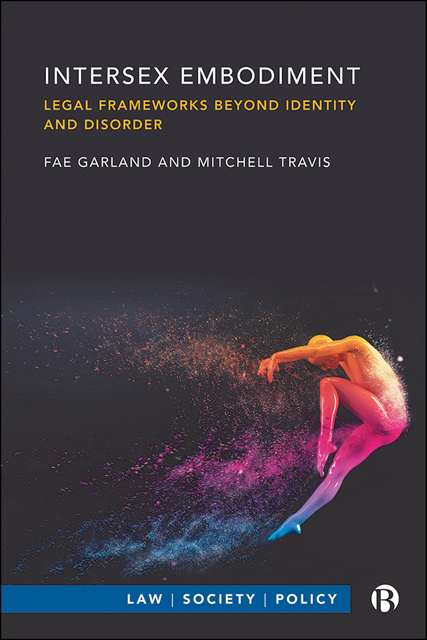Book contents
- Frontmatter
- Dedication
- Contents
- Series Editor’s Preface
- List of Abbreviations
- Acknowledgements
- 1 Introduction: Embodying Intersex
- 2 Medical Embodiment: Intersex as Disorder
- 3 Non-Binary Embodiment: Intersex and Third-Gender Markers
- 4 LGBT Embodiment: Queerness, Homonormativity and Anti-Discrimination Law
- 5 Engaging with Intersex Experience: Can Law Disrupt Medical Embodiment?
- 6 Intersex as Acceptance and Emergence: Can Psychosocial Frameworks Disrupt Medical Embodiment?
- 7 Conclusion: Intersex Embodiment
- References
- Index
7 - Conclusion: Intersex Embodiment
Published online by Cambridge University Press: 17 June 2023
- Frontmatter
- Dedication
- Contents
- Series Editor’s Preface
- List of Abbreviations
- Acknowledgements
- 1 Introduction: Embodying Intersex
- 2 Medical Embodiment: Intersex as Disorder
- 3 Non-Binary Embodiment: Intersex and Third-Gender Markers
- 4 LGBT Embodiment: Queerness, Homonormativity and Anti-Discrimination Law
- 5 Engaging with Intersex Experience: Can Law Disrupt Medical Embodiment?
- 6 Intersex as Acceptance and Emergence: Can Psychosocial Frameworks Disrupt Medical Embodiment?
- 7 Conclusion: Intersex Embodiment
- References
- Index
Summary
This book set out to examine what intersex embodiment means in the 21st century in predominantly Western societies. In doing so, it has demonstrated that there are multiple disjointed and fragmented accounts of intersex embodiment which are produced through a range of different regulatory frameworks. Each of these frameworks arguably set out to improve the lived experience of intersex embodied individuals. In reality, they often misconceptualize ‘intersex’ and consequently serve to disempower intersex embodied individuals.
The professionalization of medicine in the 19th century saw a change in the way that intersex embodiment was constructed. Conceptualizing intersex embodiment as a ‘disorder’ has prevented legal and political questions about intersex equality to be taken forward. Instead, governing logics of ‘fixing’ intersex people have dominated the ways that intersex embodiment is understood. This process of ‘fixing’, in turn, is committed to logics of binary sex and heteronormativity (Dreger, 1998; Malatino, 2019). Since the early 20th century, medical professionals have attempted to ‘normalize’ intersex children through surgical and hormonal interventions to ensure they adhere to the sex binary. While the motivations of these interventions are not to harm, but to ‘better’ the lives of their ‘patients’ by enabling heteronormative social participation, the need for interventions are based on social anxieties rather than scientific evidence; no longitudinal studies exist which prove that lived experience has actually improved as a result of such interventions. In fact, these interventions are usually non-therapeutic, and can lead to severe life-long physical and psychological problems. Surgical interventions tend to occur within the first 18 months of the child’s birth, and this, combined with the culture of secrecy that accompanies intersex variations, has led to an erasure of intersex embodiment in political and legal discourse. There have been few constructions of intersex embodiment outside the medical profession, and the shame and stigma attached to a ‘disorders of sex development’ label prevents families and individuals from speaking out. Indeed, many families go to great lengths to hide such a ‘diagnosis’ (Hegarty and Chase, 2000; Davis, 2015).
The construction of intersex embodiment as a disorder is not natural, inevitable or apolitical. The notion of intersex embodiment as a disorder is loaded with meaning that influences how intersex people understand their own bodies and choices (Karkazis and Feder, 2008: 2016).
- Type
- Chapter
- Information
- Intersex EmbodimentLegal Frameworks beyond Identity and Disorder, pp. 167 - 176Publisher: Bristol University PressPrint publication year: 2022



